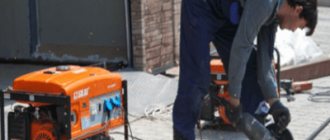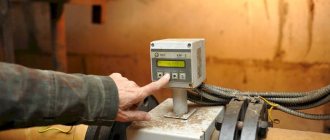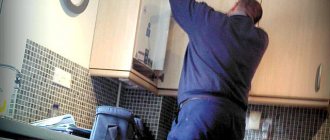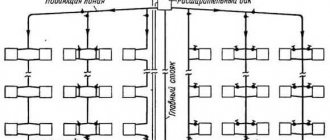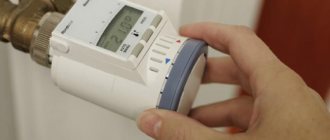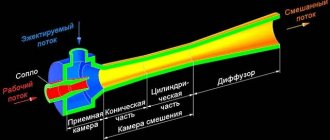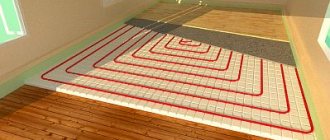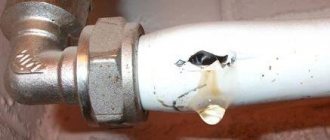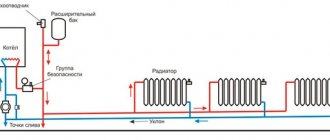Legislative regulation on heat supply cleaning
Flushing and pressure testing of heating systems is regulated by regulations and is included in the register of mandatory operations for the operation of heating structures. The regulation is enshrined in current legal acts on the filing of appeals and complaints in the event of failure of management organizations to fulfill their duties.
Decree of the Russian Government No. 354
Decree number 354 specifies the annual cleaning of home heating circuits in the form of flushing. The procedure is also carried out after the installation of communications, major repairs and routine repairs, expressed by the replacement of pipelines.
In the case of an open system, disinfection is carried out. The purpose of the treatment is to remove dirt, silt, scale and lime deposits from the inner walls of the pipes.
The operation is performed using the following available methods:
- hydraulic;
- hydropneumatic;
- chemical
Membranes and nozzles of hydraulic elevators are removed during this period. Recuperators and regenerators are cleaned mechanically or chemically. It is prohibited to use media supply lines that have not been cleaned and disinfected. After the operation, the structure is filled with water.
Decree of the State Construction Committee No. 170
Resolution of the Russian Federal Construction Authority No. 170 (current version 2021) covers issues of proper operation of the heating structure. The regulations indicate a summer inspection of shut-off valves, flushing of building blocks, and elimination of permanent and temporary blockages.
If the apartment batteries do not warm up, they undergo a hydropneumatic procedure. Section V reminds us of the annual processing of the thermal configuration after the end of the heating period, and in case of replacement of elements of open circuits, they are disinfected.
The communications are flushed with a volume of cold water that exceeds the required consumption of the hot resource at least 3-5 times, until it is completely clarified.
However, employees of management structures often carry out processing, justifying their behavior by the fact that the decree of the Federal Agency is intradepartmental and cannot be implemented. Although Art. number 2.6 talks about the preparation of housing stock for winter by its owner and local government institutions.
Watch the video: “Flushing heating systems using the hydro-pneumatic ram method.”
Decree No. 290 on flushing and cleaning heating
Order No. 290 of the Russian government provides a list of services and work that must be performed to maintain the serviceability of residential multi-story buildings.
The second chapter indicates that work is being carried out to preserve heat consumption:
- hydraulic tests of communications stability;
- flushing heating radiators, adjusting heat supply units with preliminary commissioning of furnaces;
- releasing air pockets from the structure;
- washing of networks to wash away scale-corrosion deposits;
- processing of heat exchange devices.
The Resolution does not give a clear indication of the frequency of their conduct, but makes a footnote to the order of the State Construction Committee. Timing procedures must adhere to the legislation of the country, but flushing can be carried out by decision of a meeting of apartment owners.
GOST P 56501-2015
7 facts about heating radiators.
State standard number P56501-2015 (with amendments and additions in 2021) also stipulates the conditions for processing networks. His article No. 5 talks about organizing seasonal training. Shortly before the end of the coolant supply, the contractor draws up and coordinates his actions with heating or another resource-supplying structure a plan for carrying out restoration measures - flushing, pressure testing, conservation of communications.
The contractor fulfills the conditions according to the agreed schedule, after which the acts are drawn up. The first is a legal entity that provides economic services to a multi-storey building. Before the end of winter, the housing office must draw up a list of preventative and repair work, including cleaning heat consumption units. It is carried out after stopping the supply of coolant or blocks or elements that have passed diagnostics.
Flushing the heating systems of an apartment building is carried out using the methods specified in the operating regulations. The liquid pressure used in the structures is no more than the working one, and the air pressure is no more than 0.60 MPa. The water supply speed rises above the calculated rate by half a meter per second or more. After complete clarification of the washing liquid at the outlet of the unit, the cleaning is completed. GOST P 56501-2015 prohibits leaving the circuit empty.
Construction norms SNiP 3.05.03-85 (new edition 2021) also prescribe systematic treatment of heat consumption circuits.
Referring to the listed government acts, apartment owners have the right to demand that housing companies periodically flush communications.
Purpose of the procedure
Heating systems in a private or apartment building require regular cleaning. This is necessary because from the very beginning of operation of a water heating system, its efficiency decreases by about ten percent. Operating efficiency and heating begin to be lost from the first months of the cold season. And if a specific sound appears from the pipes or heating occurs unevenly, then there is a possibility that the system is clogged.
The main coolant is water with various salts and impurities. During circulation and heating, chemical processes occur, a solid sediment appears, which is deposited on the walls of pipes and batteries. Over time, corrosion of metal joints and sludge develops. Scale deposited on the inner walls of pipes greatly reduces their performance and leads to a number of consequences:
- the level of heat transfer is weakened;
- the speed of water movement decreases;
- wear of pipes and fittings increases;
- Heating bills increase.
If the pipe clearance drops to zero, the circuit section will become completely inoperable. Regularly carried out preventive work will help to avoid emergency situations associated with pipe ruptures and fistulas.
Frequency of heating supply flushing
When the coolant passes through the pipeline, scale is deposited on the inner walls of the latter, reducing heat transfer by at least 20%. The deposits destroy the metal, causing fistulas and ruptures to appear.
Flushing performer
The operation is carried out by employees of the heating network or other resource supply structure.
Timing for flushing coolant in MKD
The regulations and conditions for the technical operation of buildings are approved by order of the Federal Construction Authority No. 170. The latter indicates the flushing of MKD units after each completion of the heating period, or major or routine repairs due to the replacement of elements in an open network. After treatment, the system is disinfected. Failure to comply with all conditions may result in the building not being allowed to participate in the heating process.
Unscheduled flushing of heat supply
The procedure is carried out after the appearance of factors that reduce the effectiveness of the circuit:
- heating the network requires additional time;
- cold radiators with a hot system;
- extraneous sounds during generator operation;
- increased boiler fuel consumption.
If the batteries heat up unevenly, the heating systems are also flushed.
Processing steps for cleaning and washing
Processing of heat consumption units is carried out in the following sequence:
- They check communications and assess their technical condition. Primary pressure testing is performed, and the pressure is set one quarter higher than the working pressure. The procedure helps identify system leaks.
- Determine the technology for washing the block. The usual method involves running a pulp consisting of a liquid with compressed air.
- An estimate is drawn up.
- An agreement is drawn up, which specifies all the terms of the operation, deadlines, obligations of counterparties, penalties in case of violation of the first.
- Then a work contract is drawn up.
- After completion, a repeat hydraulic test is carried out.
The end of flushing is determined by the execution of a certificate of cleaning and hydrotesting of the network. If the quality of the procedure is unsatisfactory, the customer has the right not to sign the agreement.
Hydrodynamic cleaning
Hydrodynamic cleaning of the heating system of a house is carried out based on the interaction of scale and salt deposits with water.
The methods of flushing the system we have considered are considered cheaper compared to the hydrodynamic type, but its efficiency is much higher.
In addition, the hydrodynamic method is used to clean cast iron radiators from scale, since the chemical material does not cope with this task efficiently.
The main advantage of the hydrodynamic method is called environmental cleanliness, because in the process of work a completely safe liquid is used to flush the heating system, without acids and alkalis - ordinary water, but under powerful pressure.
Special equipment allows you to create the required pressure, no less than 200 atmospheres.
As the diagram shows, the method of cleaning a contaminated area of the heating system looks simple at first glance: a pressure jet of water, which is supplied through special nozzles, washes the desired area.
But there are rules here, which can be considered a disadvantage of hydrodynamic flushing.
The radiator to be cleaned is delivered to a service center, where the deposits are loosened and removed using a special solvent.
And only after this, as the instructions indicate, the equipment is washed with strong water pressure.
Heat supply flushing methods
It is not recommended to start flushing the heating system without preliminary preparation. It is necessary to determine the chemical composition of scale and select a specific type of equipment for cleaning.
A technological map that prescribes all stages of the procedure will help you correctly complete the necessary steps. The latest regulation ends with the treatment of the internal area of the pipes with a chemical composition to prevent the appearance of corrosion, lime deposits, and scale.
The main washing methods are the following:
- chemical method;
- hydrodynamic;
- hydropneumatic.
Chemical flushing of coolant
This method does not involve the intervention of mechanical devices and the dismantling of radiators. Cleaning is carried out with chemicals or solutions.
However, using the method can damage the inner plane of aluminum radiators, which can lead to their destruction.
If the heating network is not very clogged, you can use the following reagents:
- sodium hydroxide;
- vinegar essence;
- ordinary phosphoric or condensed acid;
- whey.
However, it is better to use compounds that allow you to thoroughly clean the pipes. The instructions for the preparations specify the material and the nature of the layers.
Chemical treatment can be carried out using additional equipment - a booster, consisting of a centrifugal pump and a large container. The first one is connected at the break in the centralized supply system with the heating boiler. A valve must be installed at the outlet of the circuit to discharge the spent chemical.
For high-quality corrosion of lime deposits, experts recommend leaving the reagent in the network for several days, depending on its slagging level. However, to avoid exposure of the pipes to the chemical, the circuit must be rinsed with industrial or tap water after cleaning.
A more gentle metal structure is the dispersed cleaning mode. The method differs from the chemical method in that the reagent destroys the mechanical bonds of the deposits themselves, without interacting with the material of the heating communications.
Hydrodynamic cleaning
The described operation is carried out using specialized equipment. One of them is a powerful centrifugal pump with a hose having a small diameter end nozzle. Strong water pressure cleans scale and deposits from the walls of heating mains and removes them through the return line.
The disadvantage of this method is the impossibility of passing the hose around the turns of the system without opening the heating unit in many places.
Mechanical flushing method
Method for cleaning radiators and small pipes. The shut-off valves, expansion tank and centrifugal pump must be cleaned separately. Before the procedure, it is necessary to carry out a minimal drain of the house system, and then close the inlet and drain valves. Only after this they begin to reset the rest of the media.
The discharge occurs through a drain valve installed in the basement, which communicates with the sewer through a hose. This will prevent the technical subfloor from flooding with water. Radiators are cleaned by unscrewing the plug and dumping the media. However, removing the battery and processing will improve the thermal performance of the radiator.
After dismantling the radiators and areas of heating distribution to the yard, the equipment is cleaned with a cable with a brush-shaped tip. The tool is inserted into the batteries in the reverse position to the supply of thermal resources to improve the removal of scale flakes and deposits. Cleaning is carried out until the rinsing water becomes clear.
Hydropneumatic
Belongs to an effective and equipment-friendly method for cleaning heating circuits. Contains a high pressure air jet. The compressor creates high-power turbulent flows inside the communications, leading to the breakdown of build-ups and washing out accumulated dirt.
The operation is performed with a pneumatic gun that delivers short-term impulses. Lime deposits are discharged through open radiator plugs. The initial purge procedure is performed against the flow of the coolant, and the repeat procedure is performed clockwise. Removing batteries and cleaning them outside will improve air operations.
Electrohydropulse cleaning option
The method is based on the formation of an electric discharge, the shock wave of which breaks up lime deposits on the internal walls of the system, without causing harm to the latter. To carry out cleaning, you will need a voltage generator and a coaxial cable to supply high-frequency signals.
The efficiency of the method is high, so the dismantling of radiators and the entire heating circuit is not provided. After the scale is destroyed, the coolant is washed and the water goes down the drain.
Flushing - why is this procedure necessary?
The effective functioning of any modern heating system with water as a coolant depends on the temperature, magnitude and speed of the water flow flowing through the pipes. When salt deposits form and accumulate on their walls, the gaps in the pipe products become smaller. Most often this is observed in places where pipelines cut in and bend, as well as in horizontal sections. Blockages lead to the fact that heating equipment begins to work with incomplete efficiency and quickly wears out.
It has been proven that heat transfer decreases by 13–16% when deposits only 1 mm thick are formed in pipes.
Over time, the efficiency of the system becomes even less, but the cost of heating water increases. There is no point in tolerating this, since the problem can be solved, in general, quite simply - by flushing the pipes and radiators. Sanitary rules recommend carrying it out in cases where you notice the following “painful symptoms” of the functioning of the heating system:
- some areas of the battery become very hot, while others remain cold;
- the pipe connected to the battery has a high temperature, but the radiator remains cold;
- When starting up, the heating system takes a very long time to warm up, which has not been recorded before.
Most often, steel pipes that do not have a special anti-corrosion coating become clogged. In them, blockages are formed due to rusting of products and mineralization of water on the inner surface. Cast iron radiators (pipes) are also prone to the formation of deposits, in which hot water often stagnates, which leads to silting. For this reason, elements of heating systems made of cast iron and steel must be cleaned regularly, without waiting until the clearance in them drops to zero, which will require a complete replacement of the pipeline and radiators.
Clogged steel pipes
Equipment made of stainless steel and galvanized steel alloys, aluminum and bimetallic radiators require washing much less frequently. But they should also be cleaned more or less regularly, given the low quality of cleaning units and complexes installed at enterprises that supply heat to our apartments.
Complete flushing of the heating system of apartment buildings and private buildings makes it possible to get rid of deposits and deposits that have accumulated in it during operation. The cost of such an event depends on:
- length and dimensions of pipes and batteries;
- degree of contamination of the system and type of contamination;
- type of washing and equipment used for it.
The specific price for the service can be obtained from the contractor you have chosen. The cost of the latter is always determined individually. Typically, flushing the heating system of an apartment building costs at least 2.5–3 thousand rubles.
Flushing period for heating systems
A temporary planned shutdown of the heating network does not imply draining the resource from the radiators.
This is due to the following reasons:
- deposits will dry out and harden;
- After refilling, leaks will occur in the connecting areas.
Therefore, experts recommend draining water from the heating system of an apartment building only in the summer, after the end of the cold period. The spent resource is discharged into the sewer through a drain valve. To speed up the flow of water, it is necessary to open the air valves on the radiators of the upper floors. The cleaning of the risers occurs first with cold, then heated water, until the liquid coming out of the pipes carries with it mud and limestone suspensions.
At the end of the procedure, the boiler is filled with water with the addition of chemical reagents that slow down slagging of the heating circuit. The liquid level in the communications should not rise above the control mark of the safety tank.
Cleaning with water pulsating mixture
Before flushing the heating system in a private home with water, you should become more familiar with what the water-pulsating mixture is. This technology is based on the use of compressed air and water. Air is supplied to the heating system, the flows of which, together with the liquid, raise sand, salts, deposits, carbon deposits and corrosion. The subsequent supply of air removes sludge from the system, preventing it from settling. It is possible to save energy resources thanks to pneumatic-hydraulic pulse washing, while the service life of all systems is extended by 20 years or more.
The cost of cleaning in this way is a maximum of 12% of the funds that would have been spent on work to replace system components without changes and improvements. This method cleans networks without any restrictions on the time of year, because there is no need to dismantle the batteries, as well as the risers. As a result, heat transfer increases by a maximum of 95%. To flush the system in this way, it will not be necessary to rent special equipment.
Certificate of flushing and pressure testing of the heating system
Drawing up a work completion report summarizes the procedure for flushing and hydraulic testing of the heating circuit of a multi-storey building. Proper cleaning will allow home artificial heating communications to work next season.
The certificate of flushing and pressure testing of the heating system, a sample of which is given below, contains the following information:
- address of the communication location, its type - open, closed;
- cleaning method;
- materials, their volume, quantity;
- date of work;
- analysis.
At the bottom of the document are the signatures of the counterparties - the customer and the contractor.
Step-by-step instructions for an independent procedure for cleaning the coolant
It is possible to clean the artificial heating system of a building without a third party. To do this, you will need a pneumatic diaphragm pump capable of raising pressure above 6 atmospheres. Before starting the operation, you need to turn off all the valves and unscrew the radiator end caps with a wrench.
Algorithm:
- Close the resource drain valve.
- Connect the diaphragm pump to the valve located after the shut-off valve.
- Dispose of waste coolant.
- Turn on the membrane pump, raise the pressure to 6 at.
- Open the system valve.
- Turn off all house heating risers one by one. No more than 10 residential highways should be closed per run.
After the operation, you need to connect the pump through the return line to the carrier inlet into the building. However, before this it is necessary to drain the heating. After high-quality treatment of the circuit, the water should come out clear.

